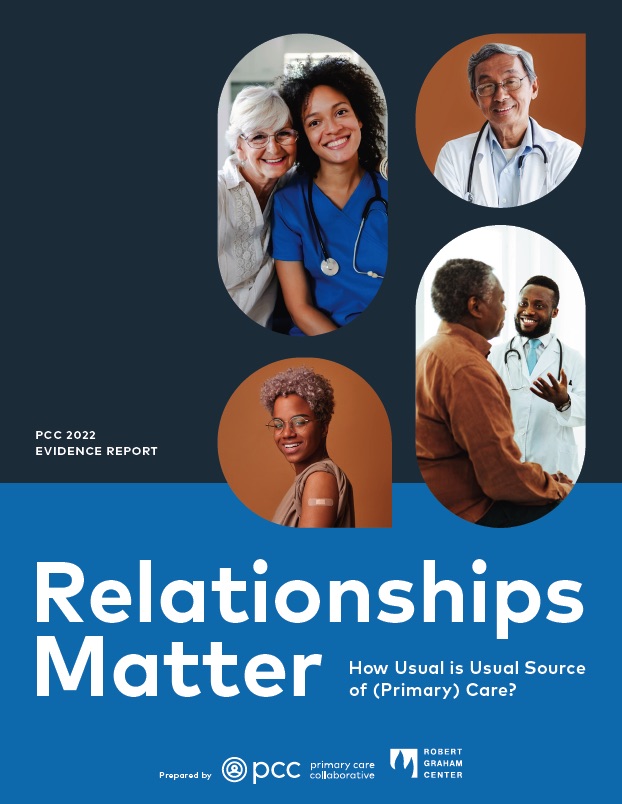You are looking at an archived version of our site. Please visit thepcc.org for a fresh, new experience!
PCC webinar: Matching Patients to Primary Care to Drive Better Health
The National Academies of Sciences, Engineering, and Medicine’s landmark report, Implementing High-Quality Primary Care, recommends "all individuals should have the opportunity to have a usual source of primary care” and suggests a role for payers in making this a reality. When patients are matched to a primary care practice or individual, preventive and pro-active care, care coordination, and trusted relationships are possible. Matching patients to an individual or team is also necessary in value-based payment models. In this webinar, an expert panel discusses proven strategies for increasing patient matching to primary care practices and how purchasers and payers can increase the share of enrollees with a usual source of care.
Thanks to Ann Kempski for planning and implementing all aspects of this webinar.
Resources related to patient empanelment/patient matching in primary care
Person-Centered Care: Why Taking Individuals’ Care Preferences into Account Matters (spoken about during the webinar by panelist Brandon Wilson)
from the Center for Consumer Engagement in Health Innovation (at Community Catalyst)
A Primary Care Physician for Every American, Science Panel Urges by Noam Levey
Higher Primary Care Physician Continuity is Associated with Lower Costs and Hospitalizations by Bazemore, et al.
Tracking Progress on Person-Centered Care for Older Adults: How Are We Doing? by Center for Consumer Engagement in Health Innovation and LeadingAge LTSS Center at UMass Boston. A survey of Americans over the age of 50 finds stark racial and income disparities in whether patients’ care preferences are taken into account by healthcare providers.
Racial and Ethnic Inequities in Health Care Coverage and Access, 2013-2019 Analysis conducted by the Commonwealth Fund indicates the share of Black and Hispanic adults with a usual source of care—defined as a personal doctor or other healthcare clinician such as a health clinic where someone would usually go if they were sick—rose almost 4 percentage points between 2013 and 2019. This modestly reduced disparities with White adults, who are most likely to have a usual source of care among the three groups, but Whites have experienced a slight decline since 2019. The improvement on this key measure stalled for Blacks and Hispanics after 2016 and is attributed primarily to a stall in the number of states that have expanded Medicaid.
How States Are Using Comprehensive Medicaid Managed Care to Strengthen and Improve Primary Health Careby Rosenbaum, et al., 2020 (for Commonwealth Fund).
A review of state Medicaid contract language relating to primary care suggests wide variation in state approaches to ensuring and encouraging primary care access.
Primary Health Care That Works: The Costa Rican Experience by Pesec, et al. With multi-disciplinary teams that serve geographically empaneled populations, Costa Rica built a robust system of primary care. The proportion of the population with access to primary care increased from 25% to 93%.
Chief Medical Officer, Covered California, Health Equity and Quality Transformation Division
Dr. Alice Hm Chen is chief medical officer at Covered California, the state’s health insurance marketplace, which actively works to ensure that Californians can find affordable, high-quality coverage. In this role she is responsible for healthcare strategy focused on quality, equity, and delivery system transformation with the goal of improving access and outcomes for all Californians. read more
President & Chief Executive Officer, Primary Care Collaborative
Ann Greiner serves as President and Chief Executive Officer of the Primary Care Collaborative (PCC), where she is focused on defining and implementing an advocacy, research and education agenda that furthers comprehensive, team-based and patient-centered primary care. read more
Director, Center for Consumer Engagement in Health Innovation, Community Catalyst
Brandon G. Wilson, DrPH, MHA, joined Community Catalyst as Director of the Center for Consumer Engagement in Health Innovation, following his tenure in federal service as a Public Health Advisor with the Centers for Medicare and Medicaid Services (CMS) Office of Minority Health. He led that office’s efforts on sexual orientation and gender inclusion (SOGI) data collection, policy efforts in post-acute care settings, and social determinants of health. He effectively engaged with federal partners and other CMS stakeholders to advance health equity in regulations, payment policy, models, and demonstrations. He also directed a strategic portfolio designed to strengthen the business case for health equity. read more
President, Value Based Solutions, Anthem
Chris Day has been President, Value Based Solutions, at Anthem, Inc., since July 2020. In that role, Chris owns the development, enhancement, and execution of Anthem’s value-based payment strategy. He is critical in developing an industry-leading risk-contracting capability and new business models that more strongly incent providers, in particular primary care, to improve quality and lower total costs. Central to the role, Chris partners with Anthem’s Lines of Business Market leaders to understand their plans and objectives, develop aligned plans within and across markets, and brings to bear contracts, provider-enablement capabilities, and product/network strategies to enable Anthem to meet and exceed its profitable growth aspirations. read more
What's New
June 12, 2024








